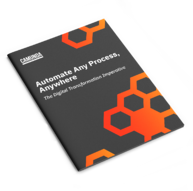Digital transformation is driving the demand for process automation solutions across every sector. Leading organizations in pursuit of greater operational efficiency and team effectiveness are deploying Camunda to automate digital commerce, drug discovery, claims processing, fraud management, fund services, risk management and more.
In my role as a sales leader, I’ve seen three main project types among the many clients I advise:
- Deconstructing monolithic systems to make code and data available to front-end systems through microservice orchestration
- Building next-gen, cloud-ready/cloud-native front-ends using Java frameworks (Angular, React, Node) that require business process and decision automation capabilities, and
- Extending core solutions to enable straight through processing while orchestrating a growing number of end-points (e.g., RPA, artificial intelligence, machine learning)
These trends and adoption patterns are especially robust among third-party administrators that offer business process services supporting operational functions such as account onboarding, customer service, claims handling and payment processing.
Automation Is the Remedy
Take for example Maximus, a leading operator of government health and human services programs. Maximus provides solutions enabling government agencies to support the Affordable Care Act (ACA), Medicaid, the Children’s Health Insurance Program (CHIP), disease investigation, unemployment insurance, and COVID-19 response efforts. In Medicaid enrollment services, Maximus is the largest provider in the U.S., serving more than 65% of Medicaid beneficiaries enrolled in Medicaid managed care.
In the past, Maximus created applications specifically designed for each customer. Every project would get its own install, requiring separate infrastructure as well as separate app development and maintenance teams to build and support solutions. Due to various state-based eligibility and enrollment policies and procedures, Maximus also had to create many instances of business rules. As a result, product development and innovation faced tremendous friction from technical debt. There was no easy way of gaining efficiencies through reusing platforms and rule sets.
Maximus decided to deconstruct old systems to harness code and rule sets while building a next-gen cloud-based platform. They embraced microservices orchestration to gain agility and scale across every end-point. Overall, they’ve benefited greatly from reduced overhead, faster innovation and competitive pricing. What used to be done in two to four months, now only takes two to four weeks. Today, their Camunda-based platform supports ACA insurance, vaccines registrations, and Medicaid eligibility and enrollment.
Modernizing to Minimize
By partnering with Camunda, Maximus and organizations alike are:
- Moving toward open source tools to reduce software license costs and vendor lock-in
- Adopting standards (e.g., BPMN, DMN) to reduce implementation costs through accelerated learning, delivery and change management, and
- Transitioning to the cloud to reduce infrastructure costs and have faster updates
This is one of many examples of organizations achieving flexibility, agility and innovation with Camunda. Check out our on-demand sessions from CamundaCon 2021 to hear our customers share their experiences with our software and its impact on evolving their business.

Automate Any Process, Anywhere
Digital transformation initiatives can’t avoid all potential roadblocks. Learn how to overcome them when they arise.
